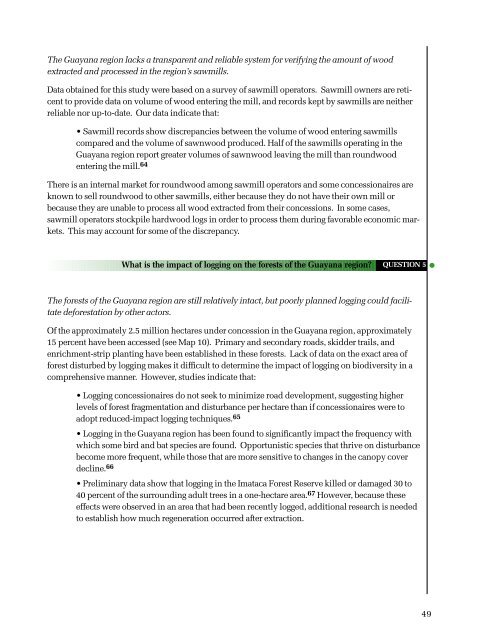Usar pâgs xvii-134 - ResearchGate
Usar pâgs xvii-134 - ResearchGate
Usar pâgs xvii-134 - ResearchGate
Create successful ePaper yourself
Turn your PDF publications into a flip-book with our unique Google optimized e-Paper software.
The Guayana region lacks a transparent and reliable system for verifying the amount of woodextracted and processed in the region’s sawmills.Data obtained for this study were based on a survey of sawmill operators. Sawmill owners are reticentto provide data on volume of wood entering the mill, and records kept by sawmills are neitherreliable nor up-to-date. Our data indicate that:• Sawmill records show discrepancies between the volume of wood entering sawmillscompared and the volume of sawnwood produced. Half of the sawmills operating in theGuayana region report greater volumes of sawnwood leaving the mill than roundwoodentering the mill. 64There is an internal market for roundwood among sawmill operators and some concessionaires areknown to sell roundwood to other sawmills, either because they do not have their own mill orbecause they are unable to process all wood extracted from their concessions. In some cases,sawmill operators stockpile hardwood logs in order to process them during favorable economic markets.This may account for some of the discrepancy.What is the impact of logging on the forests of the Guayana region?QUESTION 5•The forests of the Guayana region are still relatively intact, but poorly planned logging could facilitatedeforestation by other actors.Of the approximately 2.5 million hectares under concession in the Guayana region, approximately15 percent have been accessed (see Map 10). Primary and secondary roads, skidder trails, andenrichment-strip planting have been established in these forests. Lack of data on the exact area offorest disturbed by logging makes it difficult to determine the impact of logging on biodiversity in acomprehensive manner. However, studies indicate that:• Logging concessionaires do not seek to minimize road development, suggesting higherlevels of forest fragmentation and disturbance per hectare than if concessionaires were toadopt reduced-impact logging techniques. 65• Logging in the Guayana region has been found to significantly impact the frequency withwhich some bird and bat species are found. Opportunistic species that thrive on disturbancebecome more frequent, while those that are more sensitive to changes in the canopy coverdecline. 66• Preliminary data show that logging in the Imataca Forest Reserve killed or damaged 30 to40 percent of the surrounding adult trees in a one-hectare area. 67 However, because theseeffects were observed in an area that had been recently logged, additional research is neededto establish how much regeneration occurred after extraction.49
















